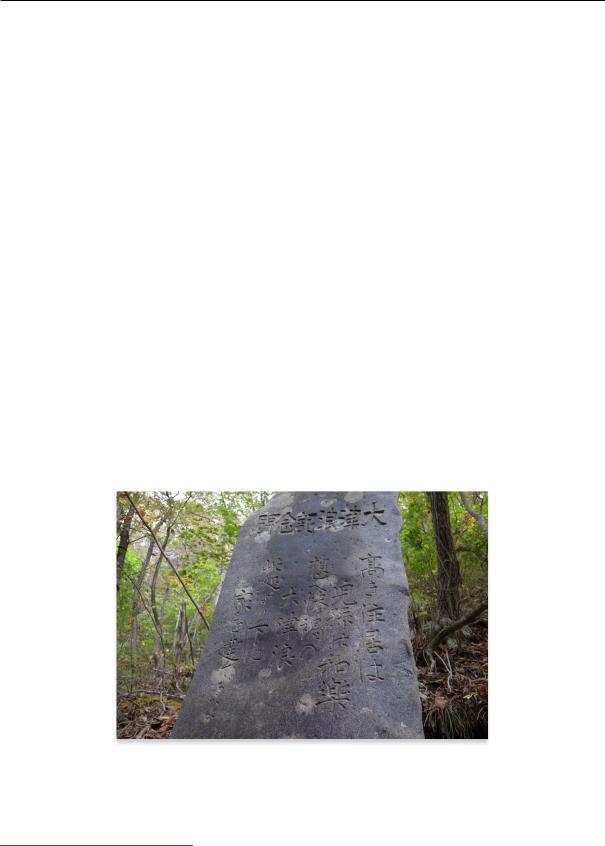
- •Final Report of the RK&M Initiative
- •Foreword
- •Acknowledgements
- •Table of contents
- •List of figures
- •List of tables
- •List of abbreviations and acronyms
- •The glossary of terms of records, knowledge and memory (RK&M) preservation
- •Executive summary
- •Key findings and recommendations
- •Chapter 1. Introduction
- •1.1. Background and scope of the RK&M initiative
- •The formulation of a dedicated initiative under the aegis of the RWMC
- •Modus operandi of the RK&M initiative
- •Key questions and objectives of the RK&M initiative
- •A product and process-oriented initiative
- •The fields of application and target audiences of the RK&M initiative
- •1.2. Evolutions in RK&M preservation thinking: A historical review
- •The RK&M reference bibliography
- •Popular themes in RK&M preservation literature
- •Landscape of Thorns
- •Atomic Priesthood
- •Summary of lessons learnt from the historical review
- •1.3. References
- •Chapter 2. RK&M preservation: Fundamentals
- •2.1. RK&M preservation and its connection to safety
- •The repository: From “seclusion and oblivion” to a societally embedded facility
- •Introducing the concept of oversight
- •2.2. Protecting humans and the environment
- •2.3. Supporting informed decision making
- •2.4. References
- •Chapter 3. RK&M preservation: Challenges and opportunities
- •3.1. Information life cycle management
- •3.2. Causes and consequences of RK&M loss
- •Lessons from RK&M loss in the nuclear field
- •Lessons from RK&M loss outside the nuclear field
- •3.3. RK&M preservation in a regulatory context
- •National RK&M preservation regulation
- •Planning responsibilities over time
- •International soft law
- •Regulation: a necessary condition for RK&M preservation
- •3.5. References
- •Chapter 4. Key characteristics of RK&M preservation approaches and mechanisms
- •4.1. Introducing the idea of a “systemic strategy” for RK&M preservation
- •4.2. Multiple time frames
- •The short term
- •The medium term
- •The long term
- •4.3. Multiple media
- •4.4. Multiple contents
- •4.5. Multiple transmission modes
- •4.6. Multiple actors
- •Multiple disciplines
- •Multiple interests, concerns and roles
- •4.7. Multiple locations
- •4.8. References
- •Chapter 5. RK&M preservation approaches and mechanisms
- •5.1. Introduction to the RK&M preservation “toolbox”
- •5.2. Dedicated record sets and summary files
- •5.3. Memory institutions
- •5.4. Markers
- •5.5. Time capsules
- •5.6. Culture, education and art
- •5.7. Knowledge management
- •5.8. Oversight provisions
- •5.9. International mechanisms
- •5.10. Regulatory framework
- •5.11. References
- •Chapter 6. Towards a systemic strategy for RK&M preservation
- •6.2. Meeting national needs
- •6.3. RK&M preservation starts today – life cycle thinking
- •6.4. RK&M preservation is an ongoing process
- •6.5. RK&M preservation is a participatory process
- •6.6. Illustration: Two fictional examples
- •Fictional example 1
- •Compliance activities
- •Best practice activities
- •Supporting activities
- •Fictional example 2
- •Compliance activities
- •Best practice activities
- •Supporting activities
- •6.7. References
- •Chapter 7. Conclusions and outlook
- •7.1. Conclusions
- •Embedding disposal facilities in society
- •Preventing inadvertent human intrusion and supporting informed decision making over time
- •Developing a systemic strategy for RK&M preservation
- •The importance of multi-disciplinarity and participation
- •7.2. Outlook
- •Upholding and elaborating an open and holistic attitude
- •Creating awareness, supporting engagement and starting RK&M preservation today
- •Developing international collaboration
- •7.3. Reference
- •Annex 1. RK&M glossary
- •Archive
- •Awareness
- •Control
- •Composite expressions
- •Cultural heritage
- •Data
- •Information
- •Knowledge
- •Composite expressions
- •Long term
- •Marker
- •Mediated/non-mediated transmission
- •Medium term
- •Memory
- •Message
- •Monument
- •Oversight
- •Record
- •Redundancy
- •Short term
- •Stakeholder
- •Systemic strategy
- •Very short term
- •References
- •Annex 2. Descriptions of RK&M preservation mechanisms
- •2.1. Mechanism description sheet: template
- •2.2. Mechanism description sheets
- •Dedicated record sets and summary files
- •Key information file (KIF)
- •Set of essential records (SER)
- •Memory institutions
- •Archives
- •Libraries
- •Museums
- •Markers
- •Surface markers
- •Monuments
- •Sub-surface markers
- •Deep geological markers
- •Surface traces
- •Time capsules
- •Large visible time capsules
- •Large invisible time capsules
- •Small time capsules
- •Culture, education and art
- •Industrial heritage
- •Alternative reuse of the disposal site/infrastructure
- •Heritage inventories and catalogues
- •Local history societies
- •Intangible cultural heritage
- •Education, research and training
- •Public information dissemination activities
- •Knowledge management
- •Knowledge retention tools
- •Knowledge risk analysis
- •Knowledge sharing philosophy
- •Oversight provisions
- •Monitoring
- •Land use control
- •Clear and planned responsibilities
- •International mechanisms
- •International regulations and agreements
- •International standards and guidelines
- •International inventories and catalogues
- •International co-operation
- •International education and training programmes
- •International archiving initiatives
- •Regulatory framework
- •National regulatory framework
- •Safeguards
- •2.3. Mechanisms overview table
- •Annex 3. Deliverables of the RK&M initiative
- •Workshop and conference proceedings
- •Studies
- •Reports
- •Website
- •Annex 4. Members and participating organisations of the RK&M initiative
- •NEA PUBLICATIONS AND INFORMATION

RK&M PRESERVATION APPROACHES AND MECHANISMS
United Kingdom 59 (see also S. Tucker in NEA, 2013a: pp. 95-97 and 108). As diversity and redundancy are key to any systemic RK&M preservation strategy, it would, in any case, be useful to keep sets of records in several archives at multiple levels. For example, sets of records could be kept in local (municipal) and regional, national, and international archives.
5.4. Markers
Markers are defined as long-lasting objects placed strategically at or near the site for immediate recognition or for discovery at a later time. Within a systemic RK&M strategy, the marker approach is meant to reach out to future generations in the medium to long term. Markers are conceived to be immobile and robust in order to maximise survivability. They should convey messages that are designed to be understandable across generations. Marking can range from a simple stone to a contrived and monumental multi-component system. The RK&M initiative dedicated two studies to the topic: a literature survey (NEA, 2013b) and a case study of the tsunami stones in Japan (NEA, 2014a).
In line with historical markers in other fields (including archaeological artefacts), much attention has been dedicated to large surface markers in the form of monuments. However, a wealth of different ideas, technologies and materials has already been proposed for marking a repository, both on the surface and underground (e.g. berms, magnets, radar reflectors, ceramic tokens, tracers, acoustic signals, etc.) (NEA, 2013b). In addition to deliberately placed markers, the idea of an “archaeology of landscapes” has also been discussed throughout the RK&M initiative (see also A. Storm in NEA, 2015a: pp. 71-73). Residual surface features may occur at disposal sites, such as bund walls built to preserve visual amenity, altered water courses or access routes for road and rail, and these may represent visual clues to previous activity. It has also been suggested that, to a certain degree, repositories mark themselves by means of their content or artificial barrier materials, implying the possibility of a message based on the detection of radioactivity or on other physical properties of disposal components (e.g. gravitational or magnetic anomalies) (see also Setzman, 2014). These elements are, however, not considered to be “markers” in the strict sense as defined in the RK&M glossary set out in Annex 1.
Markers can be conceived as both non-mediated (where the original marker remains) and mediated (where the marker is maintained, repaired or replaced) mechanisms. When conceived as an unmediated mechanism, it is recommended to integrate markers into mediated processes (e.g. in commemorations, cultural heritage schemes and education), thus combining tangible and intangible RK&M preservation components (see also Section 4.3 on multiple media and NEA, 2014a).
Although the placement of markers is typically thought to be a regulatory responsibility of implementing agencies, it is recommended that other actors are involved (e.g. local communities, semioticians and artists) (see also Graham et al., 2018; Thomson and Craighead in NEA, 2015a: pp. 133-135). At present, the use of markers is stipulated in regulation in Switzerland and the United States (see dedicated sections in NEA, forthcoming-a).60 So far, other countries do not legally require marking repositories for extended periods of time.
59.Nucleus is gradually becoming home to the archives of the entire UK civil nuclear industry, with plans, drawings, photographs, film, microfiche and documents now being stored at Nucleus. Nucleus will also host the archives of the county of Caithness, making historical documents available to members of the public (e.g. for family and local history research). Many staff members were formerly employed by the nuclear sector, and the archive has dedicated attention for public outreach and local added value and participation. See www.highlifehighland.com/nucleus-nuclear-caithness-archives.
60.The Swiss Nuclear Energy Act of 21 March 2003 stipulates that a “repository be durably marked” (see also M. Buser in NEA, 2012: pp. 87-88). The American Code of Federal Regulations on passive institutional controls states that “any compliance application shall include detailed descriptions of the measures that will be employed to preserve knowledge about the location, design and contents of the disposal system. Such measures shall include identification of the controlled area by markers that have been designed and will be fabricated and emplaced to be as permanent as practicable”.
68 |
PRESERVATION OF RK&M ACROSS GENERATIONS: FINAL REPORT OF THE RK&M INITIATIVE, NEA No. 7421, © OECD 2019 |

RK&M PRESERVATION APPROACHES AND MECHANISMS
Overall, there are currently no straightforward, conclusive answers with regard to the objectives, messages and methods of marking (NEA, 2013b; Pescatore and Schröder, 2014). It is acknowledged that even if markers remain intact and traceable over time, future neglect or misunderstanding of their message cannot be ruled out (e.g. drift in meaning due to cultural and aesthetic interpretations or even the deliberate falsification of messages). The RK&M project supports the idea that markers, if used, should be part of a systemic RK&M strategy aimed at protecting and informing future generations. This firstly means they should not intend to simply scare future generations. Depending on their material, structural design and intended time scope, the information markers are intended to carry can range from “this is man-made” to more elaborate messages. As the example of the pyramids shows, a sheer warning is not enough to keep people away. Warnings are only effective when the addressed share the same symbolic universe of the producers, and even then, men’s curious or self-confident nature may supersede. The fear of radiation may become viewed as outdated superstition, just as the fear of the gods did in the case of the pyramids (Wikander, 2015: p. 114). It secondly means that developing an RK&M strategy is never just about placing a marker. Markers should be seen as one component integrated into a broader systemic strategy based on diversity and redundancy. This means they should remain connected to other mechanisms as much as possible.
This was also the lesson learnt from the “tsunami stones” in Japan, which the RK&M initiative studied to examine the role of markers in informing subsequent generations to take appropriate actions against the potential devastation of tsunamis (see A. Van Luik in NEA, 2012: pp. 91-92; A. Van Luik in NEA, 2013a: pp. 77-79; and especially NEA, 2014a). These markers, found primarily on the country’s north-eastern shore, were brought to international attention by the 2011 Tōhoku earthquake and tsunami. They commemorate past tsunamis and carry different messages about them, for instance about how to protect oneself by not building houses close to the sea. Figure 5.2 is a picture of a tsunami stone in the village of Aneyoshi. After the village was devastated by a tsunami in 1896, the village was rebuilt in the same place. However, when another tsunami struck in 1933 the village was moved uphill. At that time the tsunami stone in the picture was put in place and is credited with saving the town in 1960 and again in 2011.61
Figure 5.2. Example of a “tsunami stone”
Note: Built in 1933 below the village of Aneyoshi. It says, “High dwellings are the peace and harmony of our descendants" and "remember the calamity of the great tsunamis. Do not build any homes below this point”.
Source: T. Kishimoto.
61.See https://99percentinvisible.org/article/tsunami-stones-ancient-japanese-markers-warn-builders- high-water.
PRESERVATION OF RK&M ACROSS GENERATIONS: FINAL REPORT OF THE RK&M INITIATIVE, NEA No. 7421, © OECD 2019 |
69 |

RK&M PRESERVATION APPROACHES AND MECHANISMS
Table 5.3. Markers: Mechanisms overview table
|
|
|
Markers |
|
|
|
|
|
|
|
|
|
|
|
|
|||
|
|
|
|
|
|
|
|
|
|
|
|
|
|
|
|
|
|
|
|
|
|
|
|
Surface |
|
|
Monuments |
|
|
Sub- |
|
|
Deep |
|
|
Surface |
|
|
|
|
|
|
|
|
|
|
surface |
|
|
geological |
|
|
|
|||
|
|
|
|
|
markers |
|
|
|
|
|
|
|
|
traces |
|
|||
|
|
|
|
|
|
|
|
|
|
markers |
|
|
markers |
|
|
|
||
|
|
|
|
|
|
|
|
|
|
|
|
|
|
|
|
|
||
|
|
Information |
|
|
x |
|
x |
|
|
|
|
|
|
|
|
|
||
|
|
Records |
|
|
|
|
|
|
|
|
|
|
|
|
|
|
|
|
|
RK&M type |
Knowledge |
|
|
|
|
|
|
|
|
|
|
|
|
|
|
|
|
|
|
Memory |
|
|
|
|
|
x |
|
|
|
|
|
|
|
|
|
|
|
|
Awareness |
|
|
x |
|
x |
|
x |
|
x |
|
x |
|||||
Scope |
Level of detail |
Low level of detail |
|
|
x |
|
x |
|
x |
|
x |
|
x |
|||||
High level of detail |
|
|
|
|
|
|
|
|
|
|
|
|
|
|
|
|
||
|
|
|
|
|
|
|
|
|
|
|
|
|
|
|
|
|
|
|
|
|
Local |
|
|
x |
|
x |
|
x |
|
x |
|
x |
|||||
|
Geographical |
Regional |
|
|
|
|
|
|
|
|
|
|
|
|
|
|
x |
|
|
National |
|
|
|
|
|
|
|
|
|
|
|
|
|
|
|
|
|
|
scope |
|
|
|
|
|
|
|
|
|
|
|
|
|
|
|
|
|
|
International |
|
|
|
|
|
|
|
|
|
|
|
|
|
|
|
|
|
|
|
|
|
|
|
|
|
|
|
|
|
|
|
|
|
|
|
|
|
|
Virtual |
|
|
|
|
|
|
|
|
|
|
|
|
|
|
|
|
|
|
Intentional |
|
|
x |
|
x |
|
x |
|
x |
|
x |
|||||
|
Intentionality |
Unintentional |
|
|
|
|
|
|
|
|
|
|
|
|
|
|
x |
|
|
Cannot be |
|
|
|
|
|
|
|
|
|
|
|
|
|
|
x |
||
|
|
|
|
|
|
|
|
|
|
|
|
|
|
|
|
|||
|
|
controlled |
|
|
|
|
|
|
|
|
|
|
|
|
|
|
||
Characteristics |
|
|
|
|
|
|
|
|
|
|
|
|
|
|
|
|
|
|
Tangibility |
Tangible |
|
|
x |
|
x |
|
x |
|
x |
|
x |
||||||
|
|
|
|
|
|
|
||||||||||||
|
Intangible |
|
|
|
|
|
|
|
|
|
|
|
|
|
|
|
|
|
|
|
|
|
|
|
|
|
|
|
|
|
|
|
|
|
|
|
|
|
Transmission |
Mediated |
|
|
|
|
|
|
|
|
|
|
|
|
|
|
|
|
|
modes |
Non-mediated |
|
|
x |
|
x |
|
x |
|
x |
|
x |
|||||
|
|
Very short term |
|
|
|
|
|
|
|
|
|
|
|
|
|
|
|
|
|
Target timescale |
Short term |
|
|
|
|
|
|
|
|
|
|
|
|
|
|
|
|
|
Medium term |
|
|
x |
|
x |
|
|
|
|
|
|
|
|
|
|||
|
|
Long term |
|
|
x |
|
x |
|
x |
|
x |
|
x |
|||||
|
|
Pre-operational |
|
|
|
|
|
|
|
|
|
|
|
|
|
|
|
|
|
Implementation |
Operational |
|
|
|
|
|
|
|
|
|
|
|
x |
|
|
|
|
Timescales |
timescale |
Pre-closure |
|
|
x |
|
x |
|
x |
|
x |
|
x |
|||||
|
|
Post-closure |
|
|
x |
|
x |
|
x |
|
|
|
|
x |
||||
|
|
Done |
|
|
x |
|
|
|
|
|
|
|
|
|
|
|
|
|
|
Development |
Pre-operational |
|
|
x |
|
x |
|
|
|
|
x |
|
x |
||||
|
Operational |
|
|
x |
|
x |
|
x |
|
x |
|
x |
||||||
|
timescale |
|
|
|
|
|
|
|||||||||||
|
Pre-closure |
|
|
x |
|
x |
|
x |
|
|
|
|
x |
|||||
|
|
|
|
|
|
|
|
|
|
|||||||||
|
|
Post-closure |
|
|
|
|
|
|
|
|
|
|
|
|
|
|
|
|
Note: This table shows the mechanisms – with a profile of their key characteristics – that belong to the RK&M preservation approach presented in this section. The full descriptions of the individual mechanisms follow, in a comprehensive, structured and standardised format, in Annex 2.2. The rows in this table are derived from those description sheets. For a full explanation of the descriptors, please see Annex 2.1.
Media reports indicated that, in some cases, the local population acted upon the warnings, whereas in many other cases, they were unaware of or ignored them. One of the main lessons from the effective markers was that complementary approaches maintained the interest in and relevance of the stones. In successful cases, markers were notably complemented with forms of intangible cultural heritage and local history (storytelling, commemorations and place names62) and education and training (the stones were taught about in school, together with insights about what tsunamis are, their potential effects and which actions one should undertake in case they occur) (see also Section 5.6 on the culture, education and art approach and its respective mechanisms in Annex 2.2). The interplay between the approaches and mechanisms appears to have been one of mutual reinforcement. For example, awareness of the
62. Or “toponyms”, such as “Octopus Grounds” and “Valley of Survivors”.
70 |
PRESERVATION OF RK&M ACROSS GENERATIONS: FINAL REPORT OF THE RK&M INITIATIVE, NEA No. 7421, © OECD 2019 |

RK&M PRESERVATION APPROACHES AND MECHANISMS
markers is passed on from generation to generation through oral history and the presence of markers keeps oral history alive. It was also interesting to learn that after important tsunamis, new stone markers were erected. After the 2011 tsunami, the initiative of creating and installing new stones63 was led by the Japanese guild of stone masons and not by the authorities. This points out the potential role of civil society organisations in developing and maintaining markers and also, the potential absence of interest by the authorities in this type of approach (NEA, 2014a: p. 8).
5.5. Time capsules
A time capsule is a purpose-built, sealed enclosure, containing a historic cache of information to be used as a means to inform future generations at a specified time or upon accidental discovery. The time capsule concept is workable and ready-to-go, with many examples of implementation and with many documented lessons learnt (see Pescatore and Van Luik, 2016). There also exists an International Time Capsule Society which strives to document all types of time capsules throughout the world.64
Time capsules can be seen as a RK&M preservation approach complementary notably to markers and archives, but also to more cultural heritage inspired mechanisms (see Section 5.6). Time capsules can involve a very large array of actors (families, corporations, societies, etc.) and they can contain a large variety of information items (including documents as well as small objects). They can have variable sizes and be placed visibly (e.g. incorporated into a surface marker) or non-visibly (e.g. small time capsules at depth in the vicinity of the repository). They can be designed for opening at an indefinite time upon discovery or at a specific time. In the latter case, openings are often overseen by a group of people and connected to a commemoration or ritual, which creates an additional, intangible form of RK&M preservation.
Some time capsules have planned lifetimes of up to 5 000 years, such as the Osaka Castle time capsule. This is a “dual-time” time capsule. Two identical time capsules were buried in 1970, with the control version designed to be recovered in the year 2000 and every 100 years thereafter.65 The opening of the control capsule at regular intervals provides the basis for a recurring ritual, as well as the opportunity to apply the most recent preservation techniques for improving the longevity of its content and potentially arresting or reversing degradation.
Time capsules have the potential to preserve records (e.g. the KIF). Additionally, when opened, they may contribute to the regeneration of knowledge (e.g. when interpretable manuals are discovered upon their opening, the content of which can also be refreshed and updated) and memory (by means of carrying contextual information, pictures, newspaper articles, small objects, etc.). They can target the short and medium term, as well as the long term (in which case they may lead to a renewed period of oversight). Also, they can be developed to deploy a mediated or a non-mediated transmission mode, or a combination of both (see the Osaka Castle example above). There is potential for the development of time capsules as a viable approach contributing to an overall RK&M strategy (see also Pescatore and Van Luik, 2016).
One of the projects the RK&M initiative addressed, the Memory of Mankind (MOM), can perhaps be understood as a particular type of time capsule and an illustration of how time capsules could be taken up in a systemic RK&M preservation strategy. It is a preservation project wherein information is printed on ceramic tablets and then stored indefinitely in the salt mine of Hallstatt, Austria. The project includes the ceramic plates that stay in the mine, but every contributing person also gets a duplicate to take home. It also has an online version, meaning that every record is also digitised. Also, every contributor and visitor receives a token with a map indicating the location of the “time capsule”. There is a plan for regular 50-year commemorations of the project. Furthermore, it is included in tourist tours due to its vicinity to a UNESCO-listed village. It combines tangible and intangible, and mediated and non-mediated approaches.
63.See e.g. www.tsunami-kioku.jp.
64.https://crypt.oglethorpe.edu/international-time-capsule-society.
65.http://panasonic.net/history/timecapsule.
PRESERVATION OF RK&M ACROSS GENERATIONS: FINAL REPORT OF THE RK&M INITIATIVE, NEA No. 7421, © OECD 2019 |
71 |
